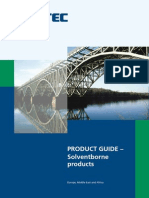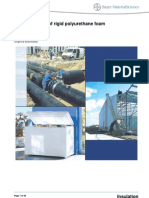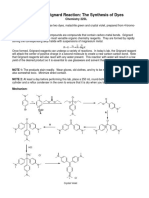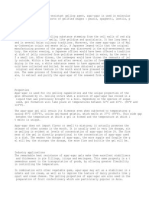Polyurethane Foams
Polyurethane Foams
Uploaded by
Ashokkumar ParthipanCopyright:
Available Formats
Polyurethane Foams
Polyurethane Foams
Uploaded by
Ashokkumar ParthipanOriginal Description:
Copyright
Available Formats
Share this document
Did you find this document useful?
Is this content inappropriate?
Copyright:
Available Formats
Polyurethane Foams
Polyurethane Foams
Uploaded by
Ashokkumar ParthipanCopyright:
Available Formats
INTRODUCTION
Polyurethanes (PU) are developing materials which is used in the form of foams, rubbers
(vulkollan), thermoplastic materials, as surface coating materials and adhesives. Polyurethanes are the
polymeric materials that is widely used in the form of foams which is used in making shoe soles,
furniture cushioning, and crash pads in automobiles, antenna housings and in sandwich structural parts.
POLYURETHANE MANUFACTURING TECHNIQUES
Polyurethanes are polymeric materials which can be manufactured by two routes
i. By the condensation polymerization of diisocyanate with dihydroxy compounds
ii. By the reaction of bischloroformates with diamines (less practiced technique).
OCN-R-NCO + HO-R-OH H2N-R-NH2 + Cl-COO-R-COO-Cl
(Less Common Route)
-[-HN-R-NH-COO-R-COO-]n-
PU elastomers are prepared by an excess of an aromatic diisocyanate such as TDI or MDI with a hydroxyl
terminated polyester or polyethers having its molecular weight in the range of 2000-3000. The excess
isocyanate would give an isocyanate terminated prepolymer.
PU FOAMS
PU foams are mainly of three types
Flexible
Rigid
Semi-rigid
PU foams are prepared out of polyesters, polyethers or natural polyols such as castor oil.
The process for producing PU foams are three, they are
1. One-Shot process
2. Pre-polymer
3. Quasi pre-polymer
By varying the raw material and process we can produce 27 basic types of PU, commercially.
RAW MATERIALS
POLYESTER BASED POLYURETHANES
Flexible PU foams are made only from polyesters and polyethers. All commercial polyesters are
based on diethlene glycol and adipic acid, partially branched by incorporation of small amount of triols.
The reaction scheme is represented as follows
(n+1) HO-CH2-CH2-O-CH2-CH2-OH + n XOOC-(-CH2-)4-COOX
HO-CH2-CH2-CH-[-O-CO-(CH2)4-COO-CH2-CH2-O-CH2-CH2-]n-OH + 2nH2O
The polymerization reaction is carried out in an inert atmosphere in a stainless steel autoclave.
The liberated water is removed by distillation. After the reaction is completed polyester is allowed to
cool and then is filtered. The rate of reaction is noted by rate of increase in viscosity and decrease in free
acid content. The foams produced by polyester are very susceptible to contamination by oil, grease and
silicones.
Polyester foams have higher density, higher tensile strength and elongation at break compared
to polyether foams. They resist actions of solvents than do the polyether foams.
POLYETHER BASED POLYURETHANES
Flexible foams of PU manufactured with polyether such as propylene oxide adducts of
monomeric polyalcohols. There are the following 5 types which are prepared by using an alkaline
polymerization catalyst.
1. POLYOXYPROPYLENE DIOLS Prepared by polymerizing propylene oxide using water and a
monomer diol as initiator.
2. POLYOXYPROPYLENE TRIOLS Prepared by using a triol initiator.
3. ETHYLENE OXIDE TIPPED TRIOLS Produced by reaction of polyoxy propylene triol chains with
ethylene oxide to increase the proportion of primary hydroxyl end groups.
4. Copolymer triols of both the random and block copolymers of ethylene and propylene oxides
5. BLENDED POLYOLS Usually a mixture of diol and triol of both oxy propylene types.
By controlling the proportion of alkaline oxide relative to polyalcohol initiator, the molecular weight of
polyethers are controlled. Most widely used polyether type is Polyoxypropylene triol which has
molecular weight of about 3000 based on glycerol.
ISOCYANATE
The next raw material for the production of PU is isocyanate. The most commonly used
isocyanates are Toluene Diisocyanate(TDI), Methylene diphenyl diisocyanate(MDI).
METHYLENE DIPHENYL DIISOCYANATE (MDI)
MDI is an aromatic diisocyanate. It exists in three isomers, 2,2'- MDI, 2,4'- MDI, and 4,4'-MDI,
however, the 4,4' isomer is most widely used. This isomer is also known as Pure MDI. MDI reacts with
polyols in the manufacture of polyurethane. It is the most produced diisocyanate, accounting for 61.3%
of the global market. The first step of the production of MDI is the reaction of aniline and formaldehyde,
using hydrochloric acid as a catalyst to produce a diamine precursor under the chemical formulation:
2 C6H5NH2 + CH2O CH2(C6H4NH2)2 + H2O
Then, these diamines are treated with phosgene to form an MDI. MDI is the least hazardous of the
commonly available isocyanates but is not benign. Compared to other organic cyanates, MDI has a
relatively low human toxicity.
TOLUENE DIISOCYANATE (TDI)
Toluene diisocyanate (TDI) is an organic compound. Two of the six possible isomers are
commercially important: 2,4- TDI and 2,6-TDI. 2,4-TDI is produced in the pure state, but TDI is often
marketed as 80/20 and 65/35 mixtures of the 2,4 and 2,6 isomers respectively.
2,4-TDI is prepared in three steps from toluene, which is doubly nitrated with nitric acid to give
dinitrotoluene. This step determines the isomer ratio of the ultimate TDI. Hydrogenation of the
dinitrotoluene produces the corresponding isomers of diaminotoluene (TDA). Finally, the TDA is
subjected to phosgenation, i.e. treatment with phosgene to form TDI. This final step produces HCl as a
byproduct and is a major source of industrial hydrochloric acid.
PU FOAM PRODUCTION PROCESS
As seen above PU foams are produced by One-shot process, Pre-polymer process and Quasi pre-
polymer process.
a) ONE SHOT POLYESTER FOAM
Produced by reacting adipic acid and diethylene glycol together with a small quantity of
trifunctional reaction component such as trimethylol propane. The polyester thus produced will have a
molecular weight of about 2000. To the polyester, TDI and water in the ratio of 65:35 is to be added
together with ingredients such as a catalyst (dimethyl benzylamide), an emulsifier (sulphonated castor
oil), a structure modifier and paraffin oil. The last component help in control pore size and prevent
splitting of foams. All the reactants are taken in a mixing head, the nozzle of which is kept closed till the
pressure, due to formation of CO2 gas, is sufficiently build up. When the nozzle is opened the foam
gushes out and may be used in coating and such other applications
b) ONE SHOT POLYETHER FOAM
Of the flexible PU-foams manufactured today the bulk consists of one-shot polyethers,
particularly because of favorable economics of the process and because polyether foams have better
cushioning properties. A typical recipe consists of a polyol, an isocyanate, a catalyst, emulsifier and
blowing agent.
The one shot polyether foam process become feasible because of most powerful catalyst that
have been developed. Earlier tertiary amines were the catalyst for both the polyesters and polyethers.
In late 1950s, Organotin catalysts were found to be quite powerful for chain extension reactions. It was
later found that by varying different quantities of a tertiary amine and tin catalyst both the gas evolution
and chain extension could be effectively controlled.
The surfactants help in dispersion of water in the hydrophobic polymer mass by reducing the
surface tension between the phases. When the cross-linking density was required to be increased
independent of isocyanate-water reaction, compounds such as glycerol and several types of amines
have been used. Increase in cross linking density led to increase in rigidity of the foam.
c) POLYETHER PREPOLYMER
Before the invention of the suitable catalyst system it was very difficult to produce PU foams by
one shot process. Hence a prepolymer process was developed. In this process the polyether is reacted
with an excess of diisocyanate to give an isocyanate terminated polymer. This polymer is sufficiently
stable if kept in dry conditions. When needed, the catalyst, the water and other ingredients must be
added to the content and foam would be produced.
d) QUASI-PREPOLYMER
This process is a three-part operation and is considered to be an intermediate between the
other two processes. When the equipment available adapts easily to a two-part system and not to a one
shot process or where the prepolymer is found to be very viscous, this method is adopted.
First part consists of combining all cyanurate with one half of the polyol to obtain a prepolymer
of low molecular weight which would have a large number of terminal isocyanate groups. The second
part consists of bringing the remaining polyol, into initimate contact with water, catalyst, etc., and also
additional hydroxy compounds. Thus a low viscosity system would result. Finally the first part and the
second part are mixed in equal amounts.
You might also like
- Fruits (French Edition) - Cedric GroletDocument485 pagesFruits (French Edition) - Cedric Groletbibisouri22% (88)
- Handbook of Grignard ReagentsDocument560 pagesHandbook of Grignard Reagentschemgg50% (2)
- Polyurethane Foam ProductionDocument42 pagesPolyurethane Foam Productionaustin100% (5)
- Epoxy Resins - Manufacturing Process of Epoxy ResinsDocument1 pageEpoxy Resins - Manufacturing Process of Epoxy ResinsChirag Thakur0% (1)
- Urethane CalculationsDocument4 pagesUrethane Calculationsalvin calimbas100% (10)
- Production of High Quality FoamDocument73 pagesProduction of High Quality FoamMOHAMMED YUSUF MAIAGOGO100% (1)
- Manufacturing of PU FoamsDocument36 pagesManufacturing of PU FoamsDIPAK VINAYAK SHIRBHATE100% (6)
- Polyurethane (PU) : HistoryDocument28 pagesPolyurethane (PU) : HistoryPrithviraj Daga83% (12)
- Synthesis of Polyurethane FoamsDocument6 pagesSynthesis of Polyurethane FoamsFarooq MuhammadNo ratings yet
- Additives PolyurethaneDocument32 pagesAdditives PolyurethaneDM Afteni100% (2)
- Project Report On Polyurethane FoamDocument6 pagesProject Report On Polyurethane FoamEIRI Board of Consultants and PublishersNo ratings yet
- Adhesive Technology & Formulations Hand Book (Hand Book of Adhesives)Document15 pagesAdhesive Technology & Formulations Hand Book (Hand Book of Adhesives)Ofoegbu Obinna50% (2)
- PU One Component Foam FormulationDocument13 pagesPU One Component Foam FormulationSiriluck NevestNo ratings yet
- Polyol Handbook BASFDocument13 pagesPolyol Handbook BASFAndersson Argote86% (7)
- 004 - Efficient Foam ProductionDocument122 pages004 - Efficient Foam ProductionNo Promises71% (7)
- Food AdditivesDocument23 pagesFood Additivesdeejay_04No ratings yet
- Group 6 Case Memo For ChipotleDocument6 pagesGroup 6 Case Memo For Chipotleapi-241435630No ratings yet
- Soap Bar QualitiesDocument5 pagesSoap Bar QualitiessdavidsonmillsNo ratings yet
- Polyurethane Chemistry1Document7 pagesPolyurethane Chemistry1Ahmed AwadNo ratings yet
- Polymer FoamsDocument17 pagesPolymer FoamsSachin PatilNo ratings yet
- Sheela Foam TRNG ReportDocument27 pagesSheela Foam TRNG ReportAbhijeetKumar100% (2)
- Polyurethanes - What Goes Into Pus?: BackgroundDocument7 pagesPolyurethanes - What Goes Into Pus?: BackgroundchincharNo ratings yet
- Polyurethane SDocument13 pagesPolyurethane SWendell SanchezNo ratings yet
- PolyurethaneDocument13 pagesPolyurethaneAnwesh Satapathy100% (1)
- Polyurethanes: Science, Technology, Markets, and TrendsFrom EverandPolyurethanes: Science, Technology, Markets, and TrendsRating: 1 out of 5 stars1/5 (1)
- CaCO3 Filled FoamDocument10 pagesCaCO3 Filled Foamrozichka100% (1)
- Polyurethane Amine CatalystsDocument19 pagesPolyurethane Amine Catalystsธนพล กัตติยบุตรNo ratings yet
- Project Report On Flexible Pu FoamDocument6 pagesProject Report On Flexible Pu FoamEIRI Board of Consultants and PublishersNo ratings yet
- Flexible FoamDocument18 pagesFlexible Foamakukerank100% (1)
- PU Foam 1 PDFDocument13 pagesPU Foam 1 PDFChandrajeet ShelkeNo ratings yet
- Foam BrochureDocument32 pagesFoam BrochureChristian Emmanuel Gallardo Rivera100% (1)
- Iso Choices and Index CalcDocument14 pagesIso Choices and Index CalcBryton Dias100% (2)
- Silicone Functions PolyurethaneDocument27 pagesSilicone Functions Polyurethaneธนพล กัตติยบุตร100% (2)
- Poly Ols For Polyurethane SDocument6 pagesPoly Ols For Polyurethane SA MahmoodNo ratings yet
- Flexible Polyurethane Foam in The Transportation IndustriDocument8 pagesFlexible Polyurethane Foam in The Transportation IndustriirwanchemNo ratings yet
- Low Voc Tdi FoamsDocument8 pagesLow Voc Tdi FoamsMuhammad SaadNo ratings yet
- PU FoamDocument33 pagesPU FoamVivek Raina100% (2)
- PuDocument5 pagesPuasoka33No ratings yet
- Memory FoamDocument6 pagesMemory FoamFrederic WustNo ratings yet
- Acrylic PolymersDocument25 pagesAcrylic PolymersKaye NicolasNo ratings yet
- PolyurethaneDocument27 pagesPolyurethaneHarshavardhan100% (1)
- Isocyanate PPT BIKASH DUTTADocument15 pagesIsocyanate PPT BIKASH DUTTAmita shil100% (1)
- What Are Synthetic Resins Applications and UsesDocument11 pagesWhat Are Synthetic Resins Applications and UsesBansal Trading CompanyNo ratings yet
- Flame Retardant Epoxy Resin Based On Bisphenol A Epoxy ResinDocument7 pagesFlame Retardant Epoxy Resin Based On Bisphenol A Epoxy ResinGajaraj GajapathiNo ratings yet
- Plasticizer Presentation March 2010Document58 pagesPlasticizer Presentation March 2010Kaushal KothariNo ratings yet
- Microcellular Shoes Ole SystemsDocument10 pagesMicrocellular Shoes Ole SystemsA Mahmood100% (1)
- PU 2003 Trouble Shooting PUDocument35 pagesPU 2003 Trouble Shooting PUmiltonhribeiroNo ratings yet
- Product Guide Solventborne Products CytecDocument28 pagesProduct Guide Solventborne Products CytecEmilio HipolaNo ratings yet
- Intro To PolyurethaneDocument26 pagesIntro To PolyurethaneKatie Ramirez100% (4)
- Experiment 1 TITLE: Alkyd Resin Preparation Based On Soya OilDocument3 pagesExperiment 1 TITLE: Alkyd Resin Preparation Based On Soya OilBakar Sulaiman100% (3)
- VV 0-1 PDFDocument4 pagesVV 0-1 PDFA MahmoodNo ratings yet
- Silicones and Structural AdhesivesDocument12 pagesSilicones and Structural AdhesivesDries Seuntjens100% (1)
- And It'S Application in Paints: Name Amulya Raj Roll No 06 Semester 5Document13 pagesAnd It'S Application in Paints: Name Amulya Raj Roll No 06 Semester 5Akash Honnappa100% (1)
- Preparation of Styrene Acrylic CopolymersDocument21 pagesPreparation of Styrene Acrylic CopolymersTorquemada PrimeroNo ratings yet
- 2006 - LIVRO - Epoxy Adhesive Formulations PDFDocument554 pages2006 - LIVRO - Epoxy Adhesive Formulations PDFÉrica Rodrigues100% (5)
- Handbook of Vinyl FormulatingFrom EverandHandbook of Vinyl FormulatingRichard F GrossmanRating: 3 out of 5 stars3/5 (1)
- Industrial Inorganic PigmentsFrom EverandIndustrial Inorganic PigmentsGunter BuxbaumRating: 5 out of 5 stars5/5 (1)
- Pu ElastomerDocument34 pagesPu ElastomerSuyash TrivediNo ratings yet
- Calculos de Poliuretano RigidoDocument46 pagesCalculos de Poliuretano Rigidosescobar86100% (1)
- Polyurethane: 1 HistoryDocument10 pagesPolyurethane: 1 Historycaturro77No ratings yet
- Proj Manuscript - 2Document38 pagesProj Manuscript - 2SomtoNo ratings yet
- Basic Plastic TestingDocument10 pagesBasic Plastic TestingAshokkumar ParthipanNo ratings yet
- Complaint Analysis - Bisk Farm Burst Chocolate 20gDocument2 pagesComplaint Analysis - Bisk Farm Burst Chocolate 20gAshokkumar ParthipanNo ratings yet
- ABS and SANDocument11 pagesABS and SANAshokkumar ParthipanNo ratings yet
- ABS and SANDocument11 pagesABS and SANAshokkumar ParthipanNo ratings yet
- Difference PDFDocument1 pageDifference PDFAshokkumar ParthipanNo ratings yet
- TG and Factors Affecting PDFDocument6 pagesTG and Factors Affecting PDFAshokkumar Parthipan90% (10)
- Four Polymerization Techniques (Bulk, Solution, Suspension and Emulsion)Document6 pagesFour Polymerization Techniques (Bulk, Solution, Suspension and Emulsion)Ashokkumar Parthipan96% (48)
- Isocyanate Index: EquivalentsDocument1 pageIsocyanate Index: EquivalentsAshokkumar ParthipanNo ratings yet
- Bulk and Solution PolymerizationDocument3 pagesBulk and Solution PolymerizationAshokkumar ParthipanNo ratings yet
- Exp 13 - FR 2 Nucleuphilic Acyl Substitution, The Synthesis of EstersDocument12 pagesExp 13 - FR 2 Nucleuphilic Acyl Substitution, The Synthesis of Estersherbie_wanNo ratings yet
- CUTZ Wooden Boards... EditingDocument2 pagesCUTZ Wooden Boards... EditingAfnan TariqNo ratings yet
- Onion Dna IsolationDocument4 pagesOnion Dna IsolationSmriti SmreetiNo ratings yet
- Trichloroisocyanuric Acid ApplicationsDocument10 pagesTrichloroisocyanuric Acid Applicationsashbhave100% (2)
- 101 Ways To Increase Testosterone NaturallyDocument79 pages101 Ways To Increase Testosterone NaturallyTadala Fellas75% (4)
- Piring Makanan SeimbangDocument1 pagePiring Makanan SeimbangnoorsurianaNo ratings yet
- Las Iguanas Menu 0113RRDocument1 pageLas Iguanas Menu 0113RRCraig SandersNo ratings yet
- San Lorenzo Ruiz National High School 4Th Grading Period COOKERY - Grade 9Document3 pagesSan Lorenzo Ruiz National High School 4Th Grading Period COOKERY - Grade 9Alona Patata LaporteNo ratings yet
- Media Preparation GuideDocument72 pagesMedia Preparation GuideAgrim KhatryNo ratings yet
- Starch and Alimentary Paste Starch and Alimentary PasteDocument18 pagesStarch and Alimentary Paste Starch and Alimentary PasteIrine Limuardo SorianoNo ratings yet
- Lactic Acid Production Using Lactic Acid Bacteria Under Optimized ConditionsDocument6 pagesLactic Acid Production Using Lactic Acid Bacteria Under Optimized ConditionsHanan HusseiniNo ratings yet
- Meat Tenderizer Marinade For SteaksDocument3 pagesMeat Tenderizer Marinade For Steakszoltan2014No ratings yet
- Cottonseed Oil OverviewDocument3 pagesCottonseed Oil OverviewVijay HemwaniNo ratings yet
- Carbon-Carbon Bond FormationDocument18 pagesCarbon-Carbon Bond FormationFaTin AziEyatiNo ratings yet
- Kinetics Study of Ester Hydrolysis in The Presence of HCL at Room Temperature Room TemperatureDocument10 pagesKinetics Study of Ester Hydrolysis in The Presence of HCL at Room Temperature Room TemperatureJuan RobinsonNo ratings yet
- What Is Natueco Farm ScienceDocument11 pagesWhat Is Natueco Farm ScienceAniruddha Malpani100% (3)
- Nitrogen Conversion Factor For Soy Protein - Codex Alimentarious (2016)Document7 pagesNitrogen Conversion Factor For Soy Protein - Codex Alimentarious (2016)Cristian GarcíaNo ratings yet
- Activating Agents and Protecting Groups Handbook of Reagents For Organic SynthesisDocument552 pagesActivating Agents and Protecting Groups Handbook of Reagents For Organic SynthesisFelipe Mascarenhas100% (2)
- ExtractionofinvisiblelipidDocument5 pagesExtractionofinvisiblelipidapi-348379275No ratings yet
- A Useful Grignard Reaction: The Synthesis of Dyes: Chemistry 223LDocument2 pagesA Useful Grignard Reaction: The Synthesis of Dyes: Chemistry 223LRamona AndronesiNo ratings yet
- Bodybuilding 101 NutrisionDocument27 pagesBodybuilding 101 NutrisionMykolas LukoševičiusNo ratings yet
- A Chinese Fermented Soybean FoodDocument10 pagesA Chinese Fermented Soybean FoodDaniel LópezNo ratings yet
- Formula 1092 Vitamin Skin SmoothieDocument1 pageFormula 1092 Vitamin Skin SmoothieNatuvore OrganicNo ratings yet
- FOOD Ingredients NUMBERS Numbers) - World of Islam - Halal & Haram FoodDocument11 pagesFOOD Ingredients NUMBERS Numbers) - World of Islam - Halal & Haram FoodAditya Rahman YaniNo ratings yet
- AgarDocument3 pagesAgarKam Msha100% (2)

































































































